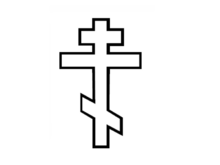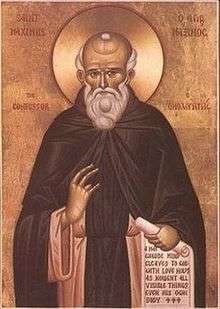August 31 (Eastern Orthodox liturgics)

The Eastern Orthodox cross
August 30 - Eastern Orthodox Church calendar - Sep. 1
All fixed commemorations below celebrated on September 13 by Orthodox Churches on the Old Calendar.[note 1]
For August 31st, Orthodox Churches on the Old Calendar commemorate the Saints listed on August 18.
Saints
- Holy 7 Virgin-martyrs, at Gaza, by the sword.[1][2]
- Holy 4 Martyrs, at Perge in Pamphylia, by fire.[2][3]
- Holy 366 Martyrs, at Nicomedia, by the sword.[2][4]
- Martyr Phileortus, by the sword.[2][5]
- Martyrs Menas, Faustus, Andrew and Heraclius.[2][6]
- Saint Diadochos.[2][7]
- Saint Gennadius, Patriarch of Constantinople (471)[2][8][9] (see also: November 17 - Greek Church[10] )
Pre-Schism Western saints
- Hieromartyr Cyprian, Bishop of Carthage (258)[8][11][12][note 2]
- Martyrs Caesidius and Companions, on the shores of Lake Fucino in Italy (3rd century)[12][13]
- Martyrs Robustian and Mark, venerated in Milan in Italy from early times.[12][13]
- Saint Paulinus, Bishop of Trier (358)[8][12][note 3]
- Saint Optatus, Bishop of Auxerre in France (c. 530)[12][13]
- Saint Barbolenus, fourth Abbot of Bobbio Abbey in Italy (c. 640)[12]
- Saint Eanswythe (Eanswith), Abbess of Folkestone (c. 640)[12][14][note 4]
- Saint Aidan, Bishop of Lindisfarne, Enlightener of Northumbria (651)[8][12][15][16]
- Saints Cuthburgh (Cuthburga)[17] and Cwenburgh, sisters, Abbesses of Wimborne (c. 725)[12][note 5]
Post-Schism Orthodox saints
- Saint John Prodrom, Metropolitan of Kiev (1089)[2][8][18][note 6]
- Saint Gennadius Scholarius (Gennadius the Scholar), Patriarch of Constantinople (1372)[2][8][20]
New martyrs and confessors
- New Hieromartyr Alexander Lyubimov, Priest, and Vladimir Dvinsky, Deacon (1918)[20][21]
- New Hieromartyrs Michael Kosukhin[2] and Myron Rzhepik, Priests (1937)[20][21]
- New Hieromartyr Demetrius Smirnov (1938)[20][21]
- New Martyrs of Jasenovac, Serbia (1941-1945)[2][8][20][21]
Other commemorations
- Placing of the Honourable Cincture (Sash) of the Most Holy Theotokos (395-408)[8][18][22][23]
- Restoration of the Church of the Theotokos at the Neorion (port facilities) in Constantinople (c. 920-944)[24][note 7]
- Repose of Schema-nun Gabriela of the Holy Trinity Monastery in Kiev (1992)[8][18]
Icon gallery
-
.jpg)
Miracle of Cincture (Greece, 17th century).
-

Icon depiction the Theotokos giving her cincture to Thomas the Apostle.
-

Saint Aidan, Bishop of Lindisfarne, Enlightener of Northumbria.
-

Gennadios II Scholarios - Fresco from the monastery "St. John the Baptist" near Serres, Greece.
Notes
- ↑ The notation Old Style or (OS) is sometimes used to indicate a date in the Julian Calendar (which is used by churches on the "Old Calendar").
The notation New Style or (NS), indicates a date in the Revised Julian calendar (which is used by churches on the "New Calendar"). - ↑ Thascius Cecilianus Cyprianus was born in North Africa. He became a lawyer, was converted to Orthodoxy and consecrated Bishop of Carthage in 248. He wrote numerous treatises on theological subjects, one of the most important being De Unitate Catholicae Ecclesiae, and wrote numerous letters. He is one of the greatest Fathers of the Church and he was a model of compassion, discretion and pastoral zeal. Cyprian went into hiding during the persecution of Decius but was arrested and beheaded under Valerian.
- ↑ Born in Gascony in France, he accompanied St Maximinus to Trier in Germany and succeeded him as bishop in 349. He was a brave supporter of St Athanasius and was therefore exiled to Phrygia by the Arian Emperor Constantius in 355. He died in exile but his relics were brought back to Trier in 396.
- ↑ Granddaughter of King Ethelbert of Kent. She founded the first convent in England on the coast near Folkestone. This was later destroyed by the Danes and swallowed up by the sea. Relics of St Eanswith are venerated in her church in Folkestone to this day.
- ↑ Sister of King Ina of Wessex, she became a nun at Barking with St Hildelith. Together with her sister St Cwenburgh, she founded a monastery in Wimborne in Dorset, where she was abbess and was succeeded by her sister. Many nuns from Wimborne helped to enlighten Germany.
- ↑ "St. John was Metropolitan of Kiev since 1080 and soon earned general profound respect. The Venerable Nestor, his contemporary, says the following about him: "this man is an expert in books, skillful in teaching, merciful to the needy and the widows, kind to everyone, rich and poor, humble and meek". St. John died in the second half of the 11th century. He left some writings, of which the following are famous: "Message of Metropolitan John to Clement, Pope of Old Rome" and "Church Canons", written for Monk James with his explanation of the Canons of the universal (catholic) Church in their application for the Russian Church."[19]
- ↑ The restored church of the Theotokos at the Neorion (port facilities) in Constantinople, was originally founded by the Patrician Antonios, and stood it in the courtyard of his home. When the Patrician Antonios died, the temple was abandoned and left desolate. Later, when Emperor Romanos I Lekapenos (920-944) prepared to demolish it, the foreman in charge of the demolition of the church was physically blocked by apparitions of the Most Holy Theotokos. Therefore the decision was taken to restore the church, and by a Golden Chrysobull, an annual grant was secured for the maintenance of the church. During the restoration, the church itself received a wonder-working grace, and many miracles were experienced by many who prayed there with faith.[24]
References
- ↑ Great Synaxaristes: (Greek) Οἱ Ἅγιοι 7 Παρθένοι. 31 Αυγούστου. ΜΕΓΑΣ ΣΥΝΑΞΑΡΙΣΤΗΣ.
- 1 2 3 4 5 6 7 8 9 10 11 The Autonomous Orthodox Metropolia of Western Europe and the Americas (ROCOR). St. Hilarion Calendar of Saints for the year of our Lord 2004. St. Hilarion Press (Austin, TX). p.64.
- ↑ Great Synaxaristes: (Greek) Οἱ Ἅγιοι 4 Μάρτυρες. 31 Αυγούστου. ΜΕΓΑΣ ΣΥΝΑΞΑΡΙΣΤΗΣ.
- ↑ Great Synaxaristes: (Greek) Οἱ Ἅγιοι 366 Μάρτυρες. 31 Αυγούστου. ΜΕΓΑΣ ΣΥΝΑΞΑΡΙΣΤΗΣ.
- ↑ Great Synaxaristes: (Greek) Ὁ Ἅγιος Φιλέορτος ὁ Μάρτυρας. 31 Αυγούστου. ΜΕΓΑΣ ΣΥΝΑΞΑΡΙΣΤΗΣ.
- ↑ (Greek) Συναξαριστής. 31 Αυγούστου. ECCLESIA.GR. (H ΕΚΚΛΗΣΙΑ ΤΗΣ ΕΛΛΑΔΟΣ).
- ↑ Great Synaxaristes: (Greek) Ὁ Ἅγιος Διάδοχος. 31 Αυγούστου. ΜΕΓΑΣ ΣΥΝΑΞΑΡΙΣΤΗΣ.
- 1 2 3 4 5 6 7 8 9 September 13/August 31. Orthodox Calendar (PRAVOSLAVIE.RU).
- ↑ St Gennadius the Patriarch of Constantinople. OCA - Lives of the Saints.
- ↑ Great Synaxaristes: (Greek) Οἱ Ἅγιοι Γεννάδιος καὶ Μάξιμος Πατριάρχες Κωνσταντινουπόλεως. 17 Νοεμβρίου. ΜΕΓΑΣ ΣΥΝΑΞΑΡΙΣΤΗΣ.
- ↑ Hieromartyr Cyprian the Bishop of Carthage. OCA - Lives of the Saints.
- 1 2 3 4 5 6 7 8 9 August 31. Latin Saints of the Orthodox Patriarchate of Rome.
- 1 2 3 The Roman Martyrology. Transl. by the Archbishop of Baltimore. Last Edition, According to the Copy Printed at Rome in 1914. Revised Edition, with the Imprimatur of His Eminence Cardinal Gibbons. Baltimore: John Murphy Company, 1916. pp. 264-265.
- ↑ St Eanswythe the Abbess of Folkestone. OCA - Lives of the Saints.
- ↑ St Aidan the Bishop of Lindesfarne. OCA - Lives of the Saints.
- ↑ Great Synaxaristes: (Greek) Ὁ Ἅγιος Aidan (Σκωτσέζος). 31 Αυγούστου. ΜΕΓΑΣ ΣΥΝΑΞΑΡΙΣΤΗΣ.
- ↑ Great Synaxaristes: (Greek) Ἡ Ἁγία Cuthburge (Βρετανίδα). 31 Αυγούστου. ΜΕΓΑΣ ΣΥΝΑΞΑΡΙΣΤΗΣ.
- 1 2 3 Dr. Alexander Roman. August. Calendar of Ukrainian Orthodox Saints (Ukrainian Orthodoxy - Українське Православ'я).
- ↑ "St. John, metropolitan of Kiev (1089)." HOLY TRINITY RUSSIAN ORTHODOX CHURCH (A parish of the Patriarchate of Moscow).
- 1 2 3 4 5 September 13 / August 31. HOLY TRINITY RUSSIAN ORTHODOX CHURCH (A parish of the Patriarchate of Moscow).
- 1 2 3 4 (Russian) 31 августа (ст.ст.) 13 сентября 2013 (нов. ст.). Русская Православная Церковь Отдел внешних церковных связей. (DECR).
- ↑ Great Synaxaristes: (Greek) Κατάθεσις Τιμίας Ζώνης τῆς Θεοτόκου. 31 Αυγούστου. ΜΕΓΑΣ ΣΥΝΑΞΑΡΙΣΤΗΣ.
- ↑ The Placing of the Cincture (Sash) of the Most Holy Mother of God. OCA - Lives of the Saints.
- 1 2 Great Synaxaristes: (Greek) Ἀνακαίνιση τοῦ Ναοῦ τῆς Θεοτόκου ἐν τῷ Νεωρίῳ. 31 Αυγούστου. ΜΕΓΑΣ ΣΥΝΑΞΑΡΙΣΤΗΣ.
Sources
- September 13/August 31. Orthodox Calendar (PRAVOSLAVIE.RU).
- September 13 / August 31. HOLY TRINITY RUSSIAN ORTHODOX CHURCH (A parish of the Patriarchate of Moscow).
- August 31. OCA - The Lives of the Saints.
- Dr. Alexander Roman. August. Calendar of Ukrainian Orthodox Saints (Ukrainian Orthodoxy - Українське Православ'я).
- The Autonomous Orthodox Metropolia of Western Europe and the Americas (ROCOR). St. Hilarion Calendar of Saints for the year of our Lord 2004. St. Hilarion Press (Austin, TX). p.64.
- August 31. Latin Saints of the Orthodox Patriarchate of Rome.
- The Roman Martyrology. Transl. by the Archbishop of Baltimore. Last Edition, According to the Copy Printed at Rome in 1914. Revised Edition, with the Imprimatur of His Eminence Cardinal Gibbons. Baltimore: John Murphy Company, 1916. pp. 264-265.
- Rev. Richard Stanton. A Menology of England and Wales, or, Brief Memorials of the Ancient British and English Saints Arranged According to the Calendar, Together with the Martyrs of the 16th and 17th Centuries. London: Burns & Oates, 1892. pp. 429-432.
Greek Sources
- Great Synaxaristes: (Greek) 31 ΑΥΓΟΥΣΤΟΥ. ΜΕΓΑΣ ΣΥΝΑΞΑΡΙΣΤΗΣ.
- (Greek) Συναξαριστής. 31 Αυγούστου. ECCLESIA.GR. (H ΕΚΚΛΗΣΙΑ ΤΗΣ ΕΛΛΑΔΟΣ).
Russian Sources
- (Russian) 13 сентября (31 августа). Православная Энциклопедия под редакцией Патриарха Московского и всея Руси Кирилла (электронная версия). (Orthodox Encyclopedia - Pravenc.ru).
- (Russian) 31 августа (ст.ст.) 13 сентября 2013 (нов. ст.). Русская Православная Церковь Отдел внешних церковных связей. (DECR).
This article is issued from Wikipedia - version of the 8/17/2016. The text is available under the Creative Commons Attribution/Share Alike but additional terms may apply for the media files.

